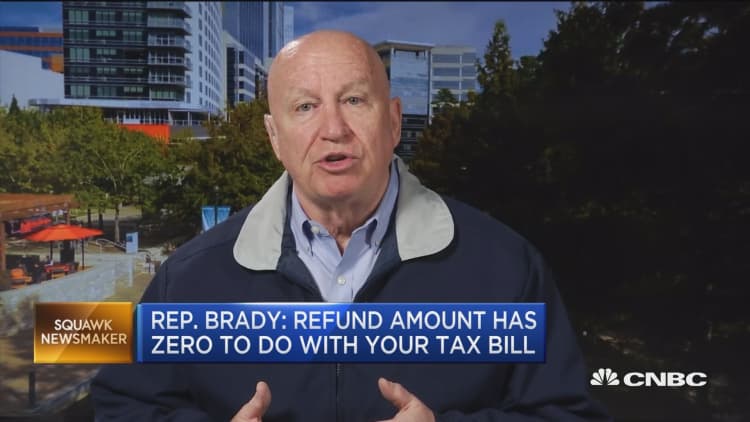
Close to a month into tax season, tax refunds are starting to increase.
The average check is now $3,143 for the week ended Feb. 22, according to the IRS. That's just about on par with last year's figures, reflecting a rise of 1.3 percent year over year.
The increase in refund amounts is a change from the recent downward trend of smaller checks.
Treasury Secretary Steven Mnuchin said in an interview with CNBC on Thursday that refunds were rising. "Tax refunds are up 17 percent week over week," he said. That basically gets us to the same level as last year."
The Treasury Department issued a statement saying the increase in the weekly data is primarily due to the remainder of the Earned Income Tax Credits and Child Tax Credits being paid out this week.
"Those two tax credits are one of the biggest determinants on whether an individual receives a refund," said Nicole Kaeding, vice president at the Tax Foundation, an independent, non-profit tax policy organization. "We need to be careful in not overinterpreting the data. It is still not clear whether at the end of the filing season refunds will be up or down compared to last year."
More from Smart Tax Planning:
What taxpayers should know about the new Form 1040
Use your tax return to unearth your spouse's money secrets
Why the average tax refund is down 16 percent
This tax season is particularly notable for filers.
It's the first time taxpayers are submitting their returns under the Tax Cuts and Jobs Act, which took effect last year.
Taxpayers have been grappling with the overhaul, which nearly doubled the standard deduction, eliminated personal exemptions and placed limits on itemized deductions.
Since the opening of filing season on Jan. 28 and up until the week ended Feb. 15, the average refund was down compared with last year.
Everyone wants to know, 'Did I save money or not with the new tax bill,' and the best way to check is to look at liability versus income.Chris BensonCPA and principal at L.K. Benson & Co.
Rep. Kevin Brady, R-Texas, who had sponsored the tax overhaul as it made its way through Congress, had told CNBC that those refunds were smaller for 2018 because taxpayers received their money in their paychecks during the year.
He said filers can retool their tax withholding at work using Form W-4.
If you withhold too much, you're likely to get a refund.
However, if you withhold less, you'll see more cash in your paycheck in the immediate term. But the following year, your refund will be smaller — or you may owe if you withheld too little.
"The people who are most likely to be surprised this year are the ones who lost some deductions they had last year and who didn't make changes to their withholding," said Nathan Rigney, lead tax research analyst at the Tax Institute at H&R Block.
Review your paycheck
In 2018, the Treasury Department and the IRS updated the withholding tables to reflect the new law.
Major changes include the end of personal exemptions, the doubling of the standard deduction and reduced individual income tax rates.
These withholding tables are guidelines that your employer follows in order to deduct the right amount of income tax from your paycheck.
The tables are intended to work alongside Form W-4, which you can use to tailor your taxes based on whether your spouse works, whether you have children and other factors.
The tax agency has been reminding taxpayers throughout 2018 to take a second look at their withholding and make estimated payments, if needed.

Even retirees were encouraged to ensure they were withholding sufficient tax from pension and Social Security payments.
Last month, the IRS announced it would waive the estimated tax penalty for filers who paid at least 85 percent of what they owed during 2018.
Normally, you have to pay at least 90 percent of your tax liability in order to avoid the penalty.
If you owe this season, consider it a lesson learned and do what you can to head off the same troubles in 2019.
It's generally a good practice to review your withholding, especially if you've been through major life changes, including getting married or having children.
Know your liability
If you're unhappy with your 2018 results, talk to your tax preparer or accountant about running a projection of your 2019 taxes.
Also, don't get too tied up fretting over the size of your refund as a chief determinant of how you fared this tax season.
Instead, look at your tax liability last year versus this year and see how they stand against your income, said Chris Benson, CPA and principal at L.K. Benson & Co. in Towson, Maryland.
"You want to compare the tax liability to your income," he said. "Everyone wants to know, 'Did I save money or not with the new tax bill,' and the best way to check is to look at liability versus income."
(CNBC Senior Personal Finance Correspondent Sharon Epperson contributed to this report.)





